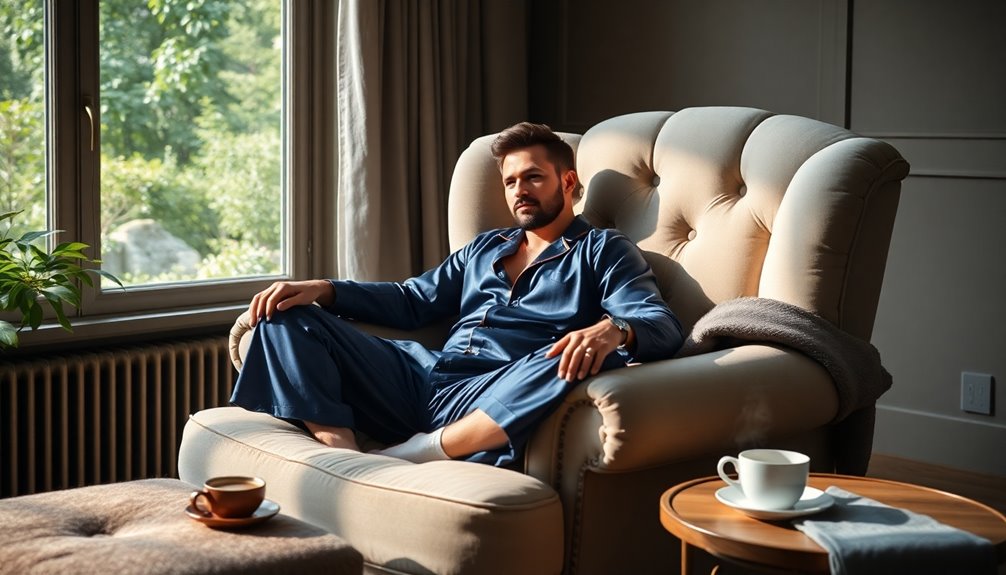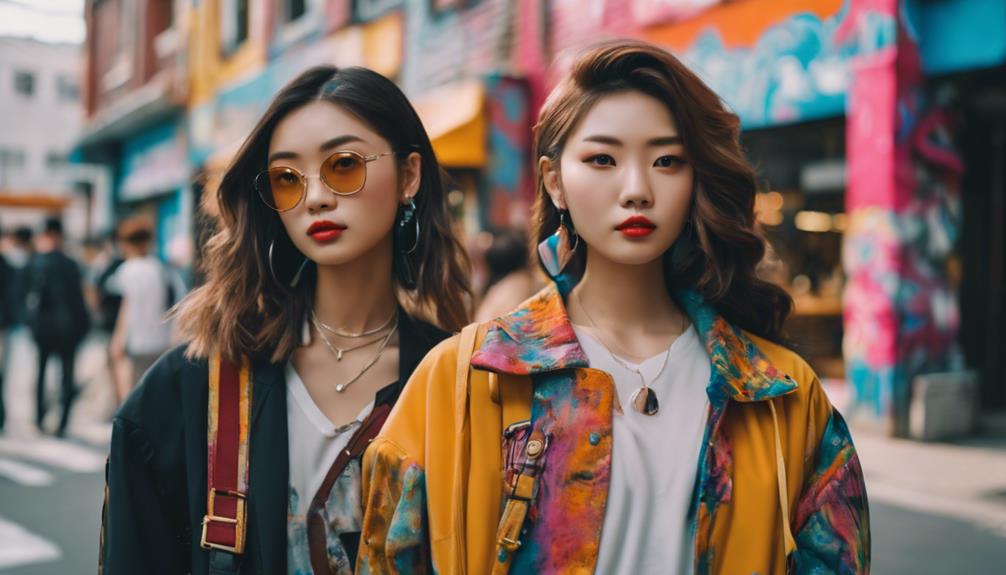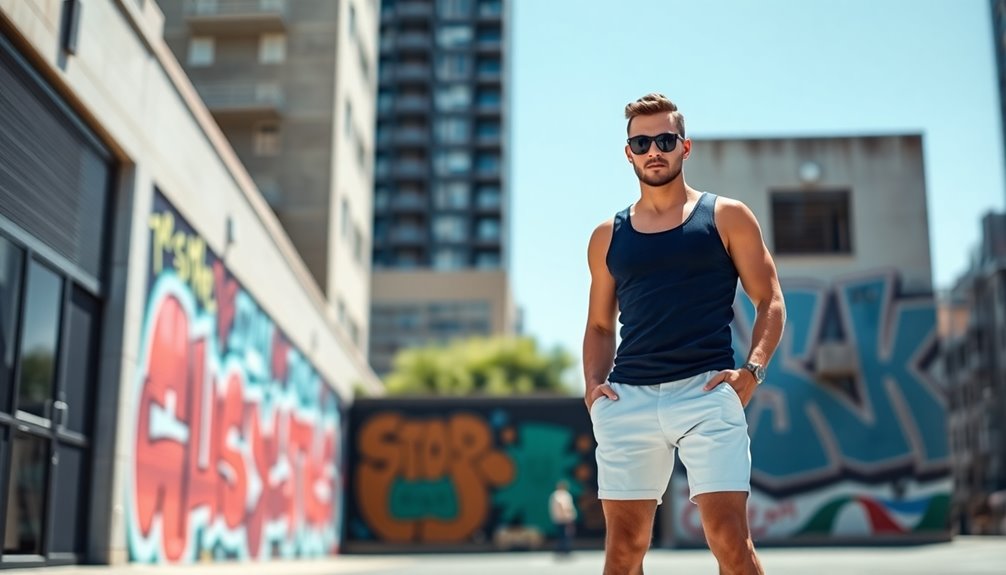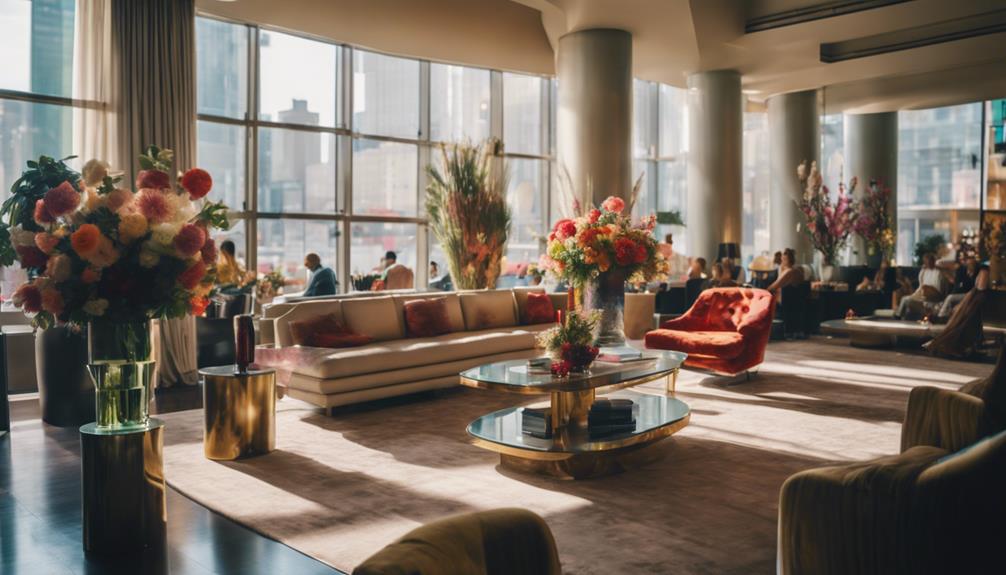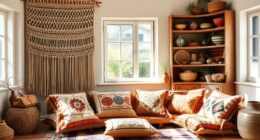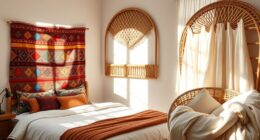To nail men's business casual, you need to follow a few key rules. First, opt for well-fitted tops like neutral button-downs or classy polos, paired with tailored dress slacks or chinos. Choose leather shoes—Oxfords or loafers—for that polished look. Layer smartly by mixing textures and adjusting for the season to add depth. Always adapt your style to your workplace culture; dress slightly better than those around you. Finally, blend casual and professional styles for a balanced appearance. Stick around to discover more tips that can elevate your business casual game.
Key Takeaways
- Opt for well-fitted, neutral-colored button-down shirts or tailored polos as your tops for a polished look.
- Choose dress slacks or chinos, with dark wash jeans acceptable in casual settings, to maintain professionalism.
- Invest in quality footwear like leather Oxfords or loafers to enhance your overall appearance.
- Layer your outfits thoughtfully, mixing textures and colors for a sophisticated yet approachable style.
- Adapt your attire based on workplace culture, observing norms and dressing slightly better than your peers.
Understand Appropriate Attire

When it comes to business casual attire, understanding what to wear is essential for making a positive impression. Start with your tops: opt for neutral-colored button-down shirts, either short or long-sleeved. Polo shirts are fine in casual settings, but make sure they're wrinkle-free and logo-free. Light blue oxford shirts are versatile, especially when paired with a suit jacket. Adding a sport coat or sweater can elevate your look.
For bottoms, dress slacks are a must. Chinos provide both comfort and style, while dark wash jeans without rips can be acceptable in many modern workplaces. Wool trousers add a level of formality that can enhance your outfit. Additionally, proper dress codes can positively impact employee performance and results.
Ensure your clothing fits well; it should hug your body without being tight or loose. Tailored pieces look polished, so avoid anything too trendy or baggy. Always keep your attire pressed and maintained for a professional appearance. Lastly, adapt your clothing to the workplace culture. Observe what your colleagues wear and err on the side of caution if you're unsure. Balancing comfort with professionalism is key to mastering business casual.
Choose Suitable Footwear
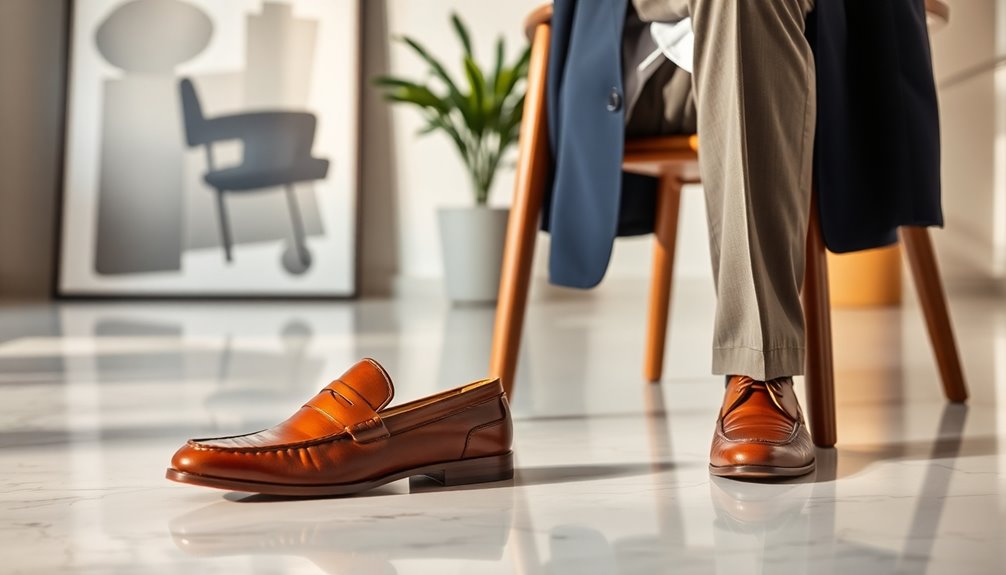
Selecting the right footwear is crucial for completing your business casual look. Traditional options like leather Oxfords, Derbies, and Monk Strap shoes provide a timeless touch that elevates your outfit. Loafers, including horsebit, penny, and tassel styles, pair well with chinos or jeans, while brogues and Bluchers maintain a professional appearance. For a versatile option, consider Chelsea boots.
In more relaxed settings, minimalistic, solid-colored sneakers can work, but make sure they're clean and stylish, not athletic. Avoid overly casual footwear like driving mocs, boat shoes, flip flops, and sandals, as they're too laid back for most business environments. Also, steer clear of shoes with large logos or flashy designs, and never wear tattered or poorly maintained shoes. Cleanliness is essential for maintaining a professional vibe in your footwear choices.
Leather shoes offer a polished look, so opt for neutral colors like black, brown, or white for the safest choices. Ensure your shoes fit well—too tight or loose can ruin your overall appearance. Polished leather not only looks professional but also leaves a lasting impression on colleagues and clients alike. Choose your footwear wisely to complete your business casual ensemble successfully.
Layering for Professionalism
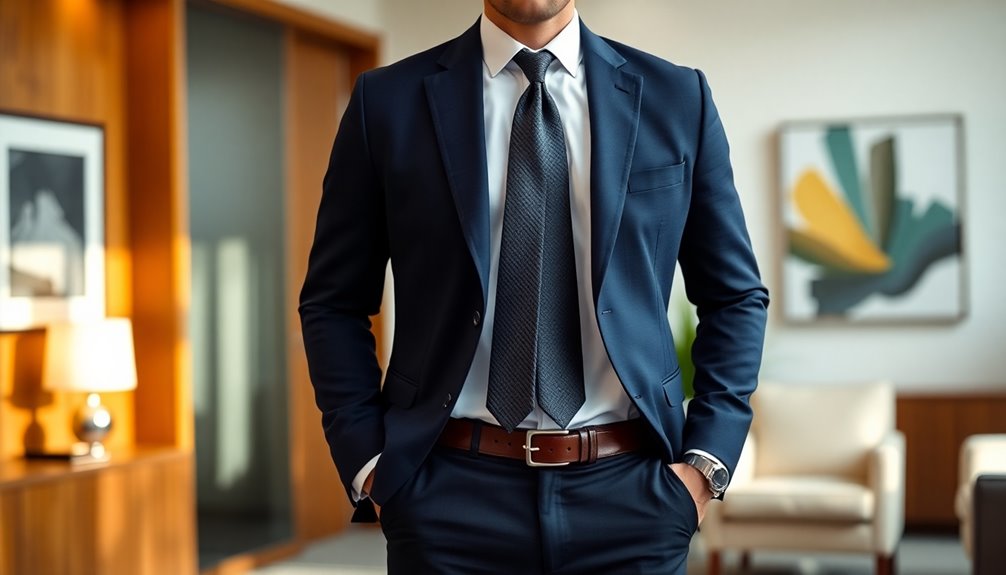
Effective layering is essential for achieving a polished business casual look. Start with a lightweight base layer like a cotton tee or a breathable polo. These should skim your body without being too tight or loose. From there, build up progressively by adding thicker pieces such as sweaters or flannel shirts. This not only keeps you comfortable but also allows you to adapt to changing temperatures throughout the day.
Mixing textures can elevate your outfit's visual interest. Pair smooth base layers with rugged outerwear, like a tweed jacket over a soft knit. Experiment with various fabrics, including denim, wool, and brushed cotton, to create depth. Mixing different textures can also enhance your overall outfit, making it more dynamic and visually appealing.
Color coordination is key. Stick to complementary colors and consider a monochrome palette or neutrals for a cohesive look. Layer similar tones for a sharp appearance that draws attention without clashing.
Finally, remember to adjust your layers based on the season. During warmer months, opt for breathable linen shirts, while cozy knits are ideal for colder weather. This versatility ensures you present a professional image in any environment.
Adapt to Workplace Culture
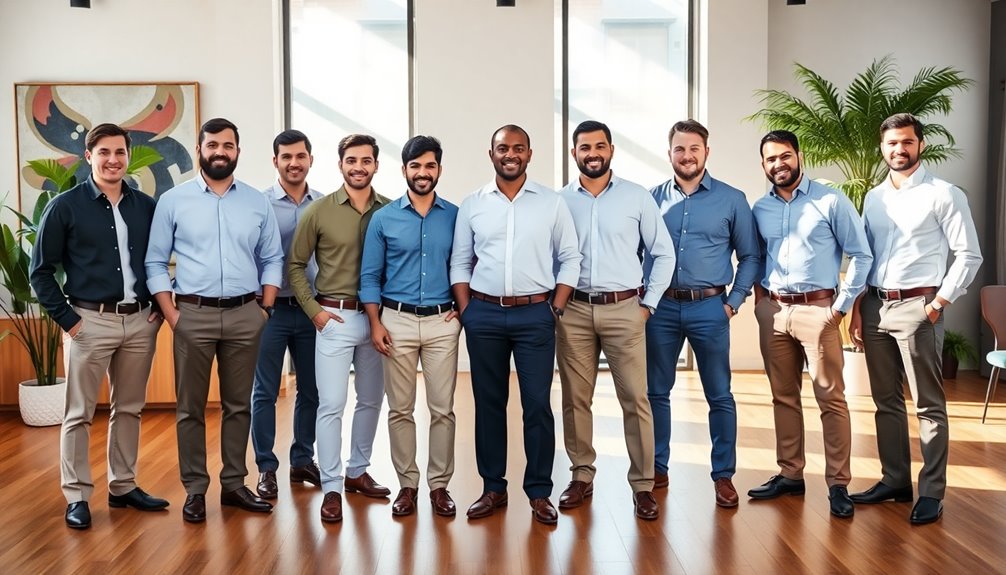
Adapting to workplace culture is crucial for navigating the nuances of business casual attire. Your outfit choices should reflect the norms of your industry. For example, if you’re in tech, jeans and casual shirts might be perfectly acceptable. In more traditional fields, opt for chinos and button-down shirts. Geographical variations also play a role; some regions embrace a more laid-back style than others. It’s essential to stay informed about the prevailing trends in your industry to ensure you make appropriate wardrobe choices. Additionally, embracing local fashion influences can further enhance your professional image; for instance, incorporating elements from Spanish style women’s fashion trends can add a unique flair to your attire while remaining sophisticated. Ultimately, balancing personal style with industry standards will help you present yourself confidently in any workplace setting.
Observe what your colleagues and superiors wear. Aim to dress slightly better than the average employee without being overly formal. Executives often set the tone, so take cues from their attire. Avoid extremes by not being the most casual or formal person in the office.
Consider your work environment too. If you're in a creative space, you might have more leeway, while client-facing roles typically require a more polished look. Pay attention to Casual Fridays and how they're observed. Even when working remotely, maintain professionalism to reflect the company culture. Balancing comfort and professionalism is key; choose versatile pieces and quality fabrics that allow for personal expression while staying within workplace standards. Additionally, industry type significantly influences acceptable business casual attire, making it essential to tailor your wardrobe choices accordingly.
Mix Casual and Professional Styles
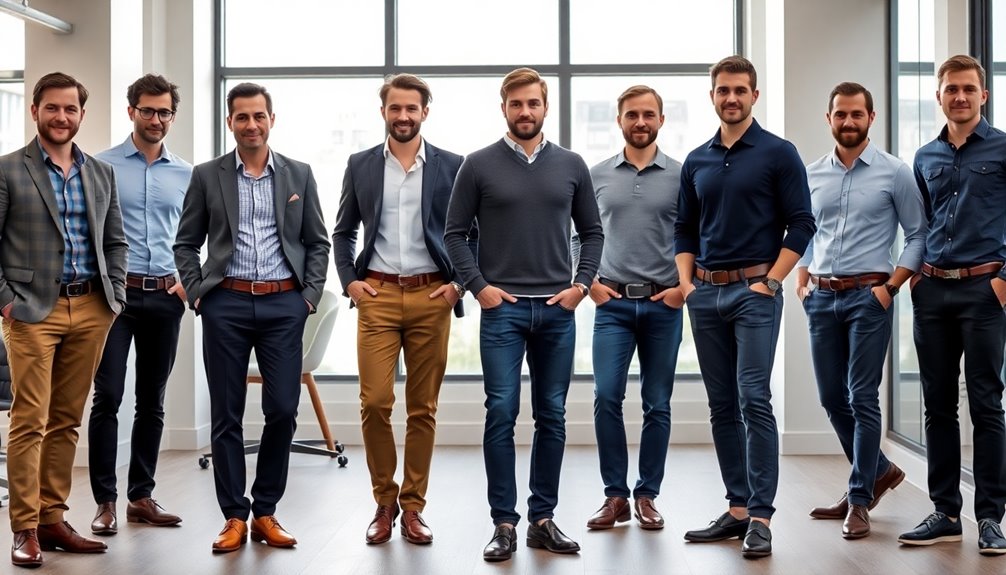
Finding the right balance between casual and professional styles can elevate your business casual wardrobe. Start with versatile button-down shirts in muted shades, which work well in various settings. If your office leans more relaxed, consider polos as a comfortable alternative. Structured T-shirts paired with chinos or trousers can give you a polished yet casual look, while textured Oxford shirts also pair nicely with jeans.
For bottoms, chinos are a classic choice that can match with almost any shirt or blazer. Dress slacks offer a more formal option, especially in traditional environments. Dark-wash jeans are increasingly accepted but ensure they're free of fading or distressing. If you're feeling a bit dressier, wool trousers are another option. Chinos with stretch are particularly useful for maintaining comfort throughout your workday.
Layering is crucial; blazers elevate your outfit's formality, and sports coats provide a relaxed touch. Cardigans and sweaters add professionalism without compromising comfort. For footwear, leather shoes like loafers or oxfords are standard, while minimalist sneakers can work in casual settings. Just steer clear of flip-flops or sandals—they're too casual for business environments. Mixing these styles will help you achieve a balanced and professional appearance.
Frequently Asked Questions
Can I Wear a Hat in a Business Casual Setting?
You can wear a hat in a business casual setting, but it depends on the environment. In more formal offices, it's best to remove your hat indoors, especially during meetings. However, if you're in a creative or relaxed workplace, hats might be perfectly acceptable. Just make sure the hat complements your outfit and reflects the office culture. When in doubt, check with a superior about the dress code.
Are Facial Hair Styles Acceptable in Business Casual Environments?
Facial hair styles can be acceptable in business casual environments, but it's essential to know your workplace's culture. Keep your beard neat and well-groomed to maintain a professional appearance. Industries vary in their acceptance; creative fields might be more lenient than conservative ones. If unsure, check your company's dress code policy and consider emulating the styles of respected leaders in your organization to ensure you align with the professional image expected.
How Should I Handle a Dress Code Violation at Work?
When you encounter a dress code violation at work, address it privately to maintain the employee's dignity. Bring them into a closed space and refer to the company's dress code policy. Explain why their outfit isn't appropriate and suggest immediate solutions, like covering up or changing. Make sure to involve them in finding a resolution, and ensure consistent enforcement of the policy to prevent future issues with attire.
Is It Appropriate to Wear Bright Colors in Business Casual?
Wearing bright colors in business casual can be appropriate, but it depends on your workplace culture. If your office leans towards a relaxed or creative vibe, you can definitely incorporate vibrant hues. However, in more conservative environments, you might want to stick to muted shades or pastels. Always observe what your colleagues wear, and balance bright colors with neutral pieces to maintain a polished and professional appearance.
What Should I Do if I'm Unsure About the Dress Code?
If you're unsure about the dress code, start by observing what your colleagues and supervisors wear. Check the company's website or LinkedIn for insights. Don't hesitate to ask HR or seasoned coworkers for clarification. If you still can't decide, lean towards slightly more formal attire—classic, clean, and well-fitted pieces are always safe. Adjust your style based on specific situations, ensuring you project a professional image at all times.
Conclusion
In summary, mastering men's business casual is all about finding the right balance. By understanding appropriate attire, choosing suitable footwear, layering effectively, adapting to your workplace culture, and mixing casual with professional styles, you'll present yourself confidently. Remember, your outfit reflects your professionalism and respect for the workplace. So, take these rules to heart, and you'll not only look the part but also feel empowered in your professional environment. Dress smartly, and success will follow!

